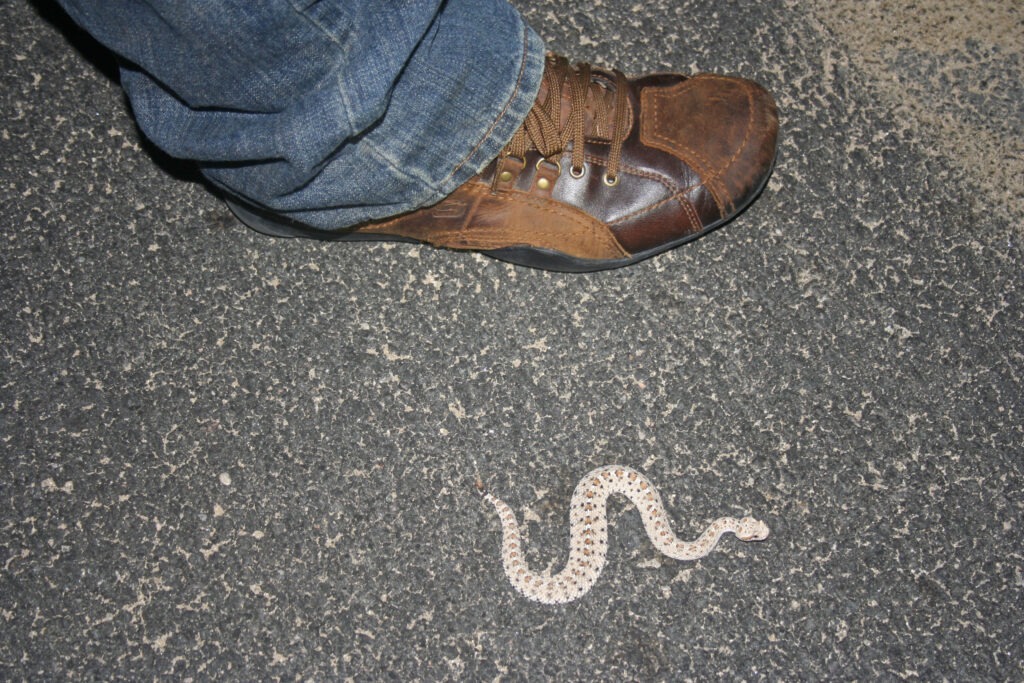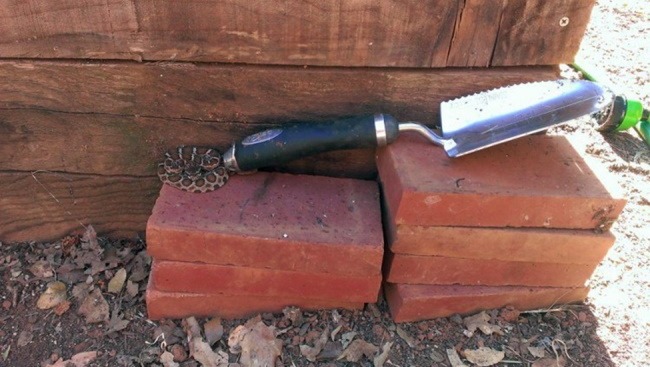
If you stumble across a baby rattlesnake in the wild, it’s important for your safety to be able to identify the venomous snake by its infamous rattle sound, but do baby rattlesnakes have rattles?
Here’s what I’ve seen:
Baby rattlesnakes do have rattles at birth with a single segment, but they will not be able to make a rattling sound until their rattle has a second or third segment. Their rattles grow 1 segment with each shed and babies shed 3-4 times a year.
Identifying a baby rattlesnake as such is vital to your safety as young rattlesnake venom is much more potent than their adult counterparts. While their markings are identical, baby rattlesnakes have a few key differences from adults, and it’s important to know the difference.
Identifying Baby Rattlesnakes
Adult and infant rattlesnakes look similar in their markings and coloration, but baby rattlesnakes are significantly smaller than adults. An infant rattlesnake is anywhere from six to twelve inches long at birth, whereas an adult is much larger at up to eight feet in length.
Most species of rattlesnake are about five feet long when they’re fully grown, but the diamondback can reach up to eight feet long.
Of course, a baby rattlesnake will have the characteristic rattle at the end of the tail, but it may be difficult to distinguish since the snake is so small and the rattle is underdeveloped. Even an adult rattlesnake can have a broken tail or a missing segment that causes the rattle to lose sound.
When in doubt, do not attempt to handle any snake that is not immediately identifiable as a safe species. Even a nonvenomous snake can harbor harmful bacteria in its mouth and can cause infection if you are bitten. Snakes are wild animals and should be left at a respectful distance.

Rattlesnakes have a proportionately large diamond-shaped head that tapers into a thin neck, and back into a thick, elongated diamond body.
Non-venomous snakes tend to have bodies that taper in a continuous line down the length of the body to the tail. This is because non-venomous snakes tend to be very active in their search for prey. After all, they do not rely on venom to take down their dinner.
Venomous snakes like the rattlesnake will have a noticeably thicker body compared to the neck and tail.
The body is thicker on the sides due to fat stores. Venomous snakes do not move as often to conserve energy and immobilize prey with nerve-destroying venom. The head is larger and thicker than the neck due to the venom gland placement right behind the lower jaw.
Both adults and juveniles have these sacks, but the juveniles are smaller and have a less defined diamond head shape.
Rattlesnake Heat Pits
Just like adults, baby rattlesnakes have two small pits below each nostril, these pits are heat sensing and help the snake navigate the ground and foliage around it and identify warm-blooded prey like rodents and small mammals.
The pits of the face of a rattlesnake are often mistaken for nostrils if one does not look close enough. This is not the case, almost all venomous snakes have these pits, and they are a distinguishing characteristic between venomous and non-venomous snakes.
Vibration Sensors
They do not have ears that hear in the same way that humans do, instead, they have ears that sense vibrations. Rattlesnakes are essentially deaf, but can still hear your footsteps vibrating the ground as you approach.
This is often the cause of many rattlesnake bites, they are simply unaware that you are approaching and are caught off guard. If they knew, they would leave before you arrived.
A snake coiled and tensed up, ratting and hissing, is in a defensive position and is warning you to stay back and away. The best way to avoid being bitten in these cases is to back away very slowly, facing the snake and not making any sudden movements. A sudden movement may startle the animal and cause them to strike.
A rattlesnake can strike within about two-thirds of its body length. So if a snake was six feet long, it could strike within four feet of the snake. Always stay a safe distance from any snake.
Vertical Pupils
Both adult and juvenile rattlesnakes have vertical pupils, much like a feline eye. Slit eyes help the snake bring in more colors and less light, making it ideal for hunting in different conditions. Vertical pupils are also ideal for ambush predators like the rattlesnake because they allow for a larger range and breadth of vision on a horizontal plane.

Fangs
Rattlesnakes have Solenoglyphous fangs, meaning that they fold up against the roof of their mouths when not in use.
These snakes shed their fangs every six weeks or so and always have several pairs of fully grown fangs lined up waiting to erupt after a fang is broken, lost, or shed.
Rattlesnake fangs are hollow like a hypodermic needle and inject venom from pouches located behind the jaw. Muscles surrounding the pouch contract and push the venom through the hollow fang and into the flesh of the prey.

Diamond Markings
Baby rattlesnakes have darker, more defined diamond markings along their spine, these lighten and thin out with age and exposure to sunlight, losing definition as they increase in size.
This difference is slight in most species, but a common rule of thumb when it comes to identifying baby rattlers is that most juveniles look like smaller versions of adults.
When to Look Out For Baby Rattlesnakes

Female rattlesnakes generally give birth in the late summer and early fall. they will stay with their young for about two weeks or until their first shed. After that, the babies are on their own.
Rattlesnakes are more often found in the dry southern states since they are exothermic and require heat from the sun to keep their bodies functioning.
Most rattlesnake bites occur during the spring and fall because this is the time that humans and snakes are outdoors in the same environment most frequently. The best way to avoid a bite from a rattlesnake is to be aware of your surroundings at all times while hiking, rock climbing, or spending time outdoors where there could be a snake.
Can You Always Hear a Baby Rattlesnake Rattle?

Baby rattlesnakes will coil up, raise their head, and vibrate their tail on instinct, even though no sound is produced. This behavior should be treated just like adults because the baby rattler is still warning you that it will strike if you get any closer.
A baby rattlesnake tail is called a “button” because it contains only one ridge and scale inside. This will quickly change as the snake grows larger.
An already aggressive species, the temperament of the baby rattlesnake is not to be messed with. Because baby rattlesnakes are born only an eighth of their largest possible size, these infants are very aggressive to protect themselves from predators and even other snakes.
If handled or provoked, a juvenile rattlesnake is much more likely to strike.
They do have less venom, but it is more potent than an adult of the same species, because of this, a bite from even a baby rattlesnake warrants a trip to the hospital.
Rattlesnakes are exothermic, or cold-blooded.
This means that they get the essential heat their body needs from external sources, such as the sun. Oftentimes, rattlesnakes of all species and ages can be found sunning themselves on rocks. This is to restore and conserve their body heat. Be wary when hiking in areas with large flat rocks or when rock climbing.
Rattlesnakes will hide in the crevices of cliffs to cool off and ambush prey such as rodents and small birds seeking refuge on the cliffside. They can also be found lounging on rocks to regain energy from the sun.
Anatomy of a Rattlesnake Rattle

What even is a rattlesnake rattle?
A rattle is a hollow section at the end of the snake’s tail that is made of interlocking keratin rings. When the snake vibrates or shakes the tip of its tail, the rings shake up and down and make the characteristic rattling sound. Each time a rattlesnake sheds its skin, the rattle adds a ring. The older a snake is, the more rings can usually be found on the tail.
Rattlesnake tails tend to be blunt on the end when they have lived in the wild.
This is because the rings break off during fights and general wear and tear. Captive snakes, however, often have rattles that taper to a point due to their comparatively stress-free lives. This is one reason it is difficult to identify the exact age of the rattlesnake using the number of rings on the rattle alone.
A group of highly specialized muscles is found within a rattlesnake’s tail to move at a speed that would make the distinctive rattling sound.
These muscles contract at a speed similar to those of a hummingbird’s wings, making it one of the fastest moving muscles in the animal kingdom. It requires a significant amount of energy to shake their tails as fast as they do, and energy is gained by proper nutrition and having enough body heat.
So on a hot day, a well-fed snake will have a stronger and faster rattling sound, often confusing onlookers due to a difference in sound frequency.
Sometimes other snakes will also appear to have a rattling sound as well. This is due to them shaking their tails in a similar fashion in an environment that would produce a similar sound. For example, shaking a tail in long dry grass could sound like a rattle on a rattlesnake. Either way, if you hear a rattling sound, it is best to avoid that area for your safety.
When baby rattlesnakes are born, they have only one ring or ridge at the tip of their tail, this is not enough to make the rattling sound.
When Do Baby Rattlesnakes Get a Rattle?
Within two weeks, a baby rattlesnake has its second shed and adds a ring to the rattle. This is still not quite enough to make a discernible sound, however. Many times the snake will shed up to 4 times before the rattle has a crisp and distinct sound. By this time, the snake will be several months old.
The first year that a rattlesnake is alive is the most active growing period.
Snake scales and the rattle on the end of the tail are both made of a substance called keratin. Keratin is the same material that your hair and fingernails are made of and is produced in large quantities by all reptiles to coat and protect their bodies from harm.
The outer layer of skin on a shedding reptile is called the corneal layer. The corneal layer is not living and does not grow with a snake.
All rattlesnake species are ovoviviparous, meaning they give birth to live young after carrying soft-shelled eggs in utero.
Because the snake hatches within the mother before being expelled, a small tough protective layer is formed over the first ring of the rattle before they are born to protect the internal organs of the mother.
This protective cover is called the button cap. Infant snakes are born with soft scales from the amniotic fluid of the egg sack or womb environment. This quickly hardens within the first few hours of life.
Baby rattlesnakes are born with a peculiar add-on to the end of their tails, the rattle is covered in an additional small fluid-filled sack covering the rattle button that protects the birth canal of the mother.
This falls off within hours of birth as well during the postpartum shed. The postpartum shed is the very first and is considered an incomplete shed as it only accounts for a small amount of skin lost, including the cap at the end of the tail.
